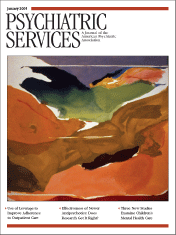"Severe" and "Chronic": Do These Terms Help Us Understand Patients?
To the Editor: The body of work by the journal's Editor Emeritus John A. Talbott, M.D., that was summarized in the October 2004 issue is impressive. I also congratulate Dr. Talbott on his successful efforts to offer a free subscription to Psychiatric Services to all members of the American Psychiatric Association (APA) as a benefit of their membership, as has always been the case for the American Journal of Psychiatry. This offer signals an end to a dysfunctional separation between patient populations that has always worried me.
I've always felt that the term "severely chronically mentally ill" is destructive, because, like the separation between members who do and do not choose to receive Psychiatric Services, it separates a stigmatized population from a more high-functioning population who also have severe and chronic mental illness but are never thought of as "severely chronically mentally ill."
I view differences between patients from the perspective of functioning. Consider the following patients whom I've treated. During the early years of my career, when Governor Reagan was closing hospitals in California, a friend asked me to drive to the Pacific Coast Highway to sign a paper for a naked 80-year-old man who was sitting on the roadside. A few years later I was treating "young chronics," who didn't have a new disease but were simply reacting to social reengineering. And then there was the 70-year-old man who had been "liberated" from Pilgrim State Hospital after 40 years by the civil rights movement and consigned to rotating between the Tombs Prison and Bellevue because he couldn't get sane enough to stand trial and wanted only to go back to Pilgrim State—but couldn't because Bellevue Hospital wasn't in the Pilgrim State catchment area. I've also run high schools for girls who lived in abandoned buildings and subway stations, and I've managed programs for evaluating and paying private disability insurance for high-functioning CEOs and police officers. The differences between these individuals are a matter of function. They are all seriously mentally ill, and their illnesses are chronic.
The adjectives "chronic" and "severe" have never helped me understand who will function and who won't—and therein lies quality of life. Severity, in my experience, doesn't differentiate persons with mental illness who need case management and a lifetime system of care from those patients with severe and chronic illness who work as CEOs, managers, secretaries, and oil riggers and occasionally need help with the barriers in the health care system. For me the dividing line between patient groups is not chronicity or severity but the ability to organize and thereby function (most of the time), which is preserved among many people in both groups irrespective of diagnosis, chronicity, or severity.
I believe that sending Psychiatric Services to all APA members could change such attitudes over time. I thank John Talbott for helping to secure this benefit for members—and for all his efforts over the years on behalf of patients.
Dr. Scott is a lecturer at Harvard Medical School and a consultant to the Boston Police Department.



